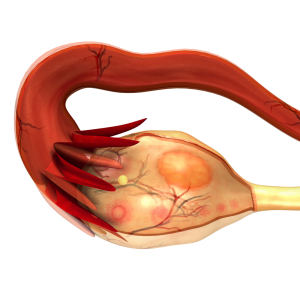Introduction
First of all, ovarian cancer can refer pain into the right or left lower abdomen. Unfortunately physicians often overlook this type of cancer in the early stages.
Also, cancer of the ovary is a very common cancer in women. About 1 in 70 women get it and 1 in 100 women die of it. Frequently, it occurs most commonly around or after menopause. It is important to realize that a small group of women will get it in the mid 30’s. A genetic trait in the family explains these early ovarian cancers. It links with other cancers such as breast cancer.
Ovarian Cancer Symptoms
Unfortunately in the early stages of the disease ovarian cancer is mostly asymptomatic. However, a pelvic mass can be felt during a physical examination. In this case which it will prompt the physician to do more tests. Whenever an ovarian mass twists itself spontaneously, it will present as lower abdominal pain on the right or left. With this in mind, the doctor would then examine carefully, maybe do an abdominal ultrasound to identify the mass and do some blood tests. If the ultrasound shows an ovarian tumor, a CT scan may reveal more details. The doctor is looking for tumor markers with the name beta-human gonadotropin hormone, CA 125 (cancer antigen 125), LDH and alpha-fetoprotein.
Ovarian Cancer Treatment
The physician stages the ovarian cancer before choosing the appropriate treatment. In oder to do this, the oncologist has a protocol to find out the spread of the tumor. This tells the oncologist how aggressive the treatment has to be to get the highest possible cure rate. Depending on the stage, the therapy might only consists of surgical removal of the tumor, called ovariectomy (if localized), or the addition of postoperative therapy such as chemotherapy. For more information see the more detailed ovarian cancer chapter by clicking on this link.
References
1. DM Thompson: The 46th Annual St. Paul’s Hospital CME Conference for Primary Physicians, Nov. 14-17, 2000, Vancouver/B.C./Canada
2. C Ritenbaugh Curr Oncol Rep 2000 May 2(3): 225-233.
3. PA Totten et al. J Infect Dis 2001 Jan 183(2): 269-276.
4. M Ohkawa et al. Br J Urol 1993 Dec 72(6):918-921.
5. Textbook of Primary Care Medicine, 3rd ed., Copyright © 2001 Mosby, Inc., pages 976-983: “Chapter 107 – Acute Abdomen and Common Surgical Abdominal Problems”.
6. Marx: Rosen’s Emergency Medicine: Concepts and Clinical Practice, 5th ed., Copyright © 2002 Mosby, Inc. , p. 185:”Abdominal pain”.
7. Feldman: Sleisenger & Fordtran’s Gastrointestinal and Liver Disease, 7th ed., Copyright © 2002 Elsevier, p. 71: “Chapter 4 – Abdominal Pain, Including the Acute Abdomen”.
8. Ferri: Ferri’s Clinical Advisor: Instant Diagnosis and Treatment, 2004 ed., Copyright © 2004 Mosby, Inc.







